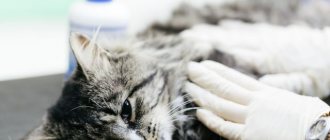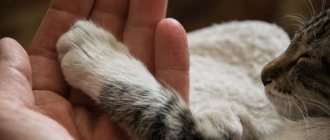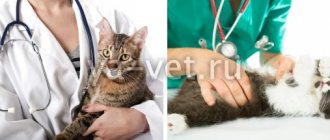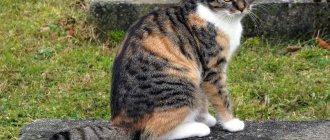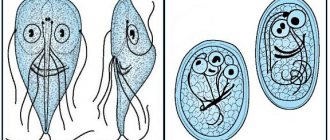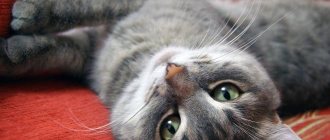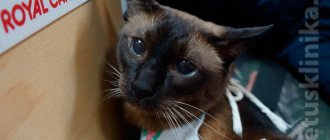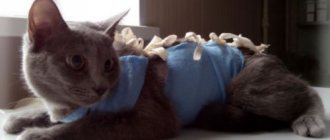Among various systemic diseases that develop against the background of metabolic disorders in the body, one of the leading places is occupied by hyperparathyroidism. This pathology occurs with increased leaching of calcium salts from bone structures and their penetration into the systemic system.
According to physiological standards, the amount of total calcium contained in the body, in the bones of the skeleton and teeth, is 99% and only 1% is found in the blood. The development of hyperparathyroidism in cats leads to imbalance and systemic disorders in the animal's body.
As the pathological process develops, the pet experiences pain in the bones and joints, the function of the musculoskeletal system is disrupted, and dyspeptic disorders and disorders in the nervous system develop. It is extremely important for the owner to notice the first changes and characteristic signs of hyperparathyroidism in order to seek qualified help and prevent the development of possible serious complications.
Description
There are 2 forms of hyperparathyroidism:
- Primary - characterized by increased levels of parathyroid hormones. The disease occurs due to dysfunction of the gland itself. This form of pathology is very rare. Typically, primary hyperparathyroidism is diagnosed in older cats with parathyroid hyperplasia or enlarging tumors.
- The secondary form is the most common. Its development is caused by kidney disease, in which the balance of electrolytes in the body is disturbed. As a result, the amount of phosphorus increases and the level of calcium in the blood decreases. To correct the imbalance, the body begins to intensively produce parathyroid hormone. Against the background of such disorders, there is a decrease in the level of calcitrol, which is the active form of vitamin D. It is produced in the kidneys and helps improve the absorption of calcium from the intestines. Its deficiency in the body leads to disruption of the process of bone mineralization.
A nutritional form of hyperparathyroidism, caused by excess phosphorus in the diet, is common in kittens. For normal formation of bone tissue, the ratio of calcium and phosphorus in the skeleton and blood must be constant.
An imbalance occurs as a result of the kitten's intake of predominantly meat food, which is rich in phosphorus but contains little calcium. A cat is a predatory animal that, under natural conditions, eats its prey along with the bones, thus replenishing its body with calcium. Pet owners often feed them beef, chicken, liver, and sausage. Introducing cottage cheese and milk into the diet does not save the situation, since the level of phosphorus in dairy products is 2 times higher than the amount of calcium.
Kittens are susceptible to the disease due to the fact that the growing body requires tens of times more calcium compared to an adult. Most often, Maine Coons, Siamese, British and Scottish kittens suffer from hyperparathyroidism.
The progression of the disease leads to the formation of multiple pathological bone fractures - both folded and microfractures, which are not visible on x-rays. Damage to the pelvic bones causes severe deformation of the pelvis and disruption of the bowel movement. Fractures or cracks in the spine cause neurological disorders.
Prognosis for the disease
Without treatment, the pathology will only worsen and ultimately lead to the death of the animal. Hypercalcemia in the chronic stage provokes damage to the kidneys and central nervous system.
With timely detection of parathyroid adenoma and its successful surgical treatment, the prognosis is favorable.
Any ailment in a cat requires investigation, for this you need to seek help from the specialists of the RosVet CC. Make an appointment with an endocrinologist by phone, 24 hours a day. Do not try to treat the animal yourself; visible symptoms are only echoes of internal disorders and can develop against the background of hundreds of causes, which only a veterinarian with extensive practice can differentiate.
Causes
Causes of primary hyperparathyroidism include:
- Malignant and benign tumors of the parathyroid gland.
- Congenital disorders in which the parathyroid gland produces excessive amounts of parathyroid hormone.
Symptoms of the primary form of the disease are more common in older animals, with cats getting sick less often than dogs.
The secondary form of pathology develops due to:
- Calcium deficiency, poor absorption of this substance by the body.
- Kidney failure.
- Gastrointestinal diseases.
- Diseases of the thyroid gland.
- Excess in the diet of foods rich in phosphorus.
- Accelerated growth of kittens aged 1-7 months.
Hormones affecting calcium balance
The optimal amount of minerals in the blood, including calcium, is ensured by the action of hormones. One of these is parathyroid hormone, which is synthesized by the parathyroid organ. Under its influence, the calcium needed by the body is borrowed from the bones, and the kidneys begin to work to maximize the retention of these ions.
Mineral imbalance is followed by deterioration in well-being
The thyroid gland produces calcitonin, a specific hormone that has the opposite effect, thereby maintaining a healthy mineral balance. An incorrect balance can have detrimental consequences for your pet's health.
Symptoms
At the initial stage of the disease, the cat becomes lethargic and apathetic, constantly lies in one place, gets nervous, and tries to run away when picked up.
Over time, the animal develops severe pain in the bones, the pet becomes aggressive, and when trying to pet or pick it up, it hisses and may bite.
When the disease enters the active phase, its symptoms become noticeable even to the most inattentive owners. The cat experiences pain when walking and limps. With sudden movements (for example, jumping from a chair), fractures and microcracks form in fragile bones. The pet's gait changes: it moves slowly, on widely spaced paws.
There are also the following symptoms:
- Deformation of the pelvic bones and sternum.
- Impaired tooth growth, tooth loss.
- Problems with urination and bowel movements (retention or incontinence).
- Development of complete or partial paralysis of the paws.
- Abdominal bloating.
- Curvature of paws.
Progression of the disease and lack of treatment leads to the development of arthritis caused by pathological changes in bone tissue.
Laboratory diagnostic methods
When examining the urine of animals suffering from hyperparathyroidism, a slight decrease in calcium levels is noted. The amount of phosphorus in the blood and urine does not deviate from the norm. Changes indicating reduced skeletal mineralization are detected only in advanced stages of the disease.
X-rays are used to confirm or refute the diagnosis. The bones of sick animals in the photographs look transparent, have thinned walls, and low density. The boundaries between soft tissues and bones are erased, and already healed fractures can be detected.
X-rays help assess the degree of bone deformation. The prognosis for a successful recovery is made based on the condition of the spine, thoracic and pelvic bones.
Cats with neurological disorders are carefully examined for spinal injuries. The pictures may show cracks, curvatures, deformation of the vertebrae, and hernias.
If an X-ray examination reveals a full intestine or bladder, the animal is given immediate assistance.
To obtain high-quality x-rays, the pet must remain motionless for several minutes, which causes difficulties during this procedure. If, due to severe pain and anxiety, the cat does not want to lie still, you need to be patient and calm the animal. The effectiveness of further treatment largely depends on the quality of the images obtained and the accurate diagnosis.
Treatment
Treatment depends on the severity of the disease, its type and existing complications. In both primary and secondary forms of the pathology, the pet is prescribed a diet that includes calcium-rich foods. Food containing a lot of phosphorus is given in moderate doses. To clearly control the amount of mineral compounds your cat eats, the veterinarian recommends switching to special balanced food. When buying finished products for animals, you must remember that most feeds contain 4 times more phosphorus in relation to calcium. You can only give a sick cat food that contains more calcium and is low in phosphorus.
If treatment is started in a timely manner, adjusting the diet will quickly restore the animal’s health. If the bones have undergone deformation, no medicine will help return them to their previous shape.
First aid
If there is severe pain, the animal is placed in a special container that limits its movement. This helps prevent further injury to the bones and speed up their healing. The pet spends 3-4 weeks in such a container. During this time, he is given medications to strengthen bones, as well as vitamin preparations.
The following are used as drug therapy:
- Chondartron is an injection solution that has anti-inflammatory, regenerating, chondoprotective and analgesic effects. Used in the treatment of the musculoskeletal system in cats and dogs. The drug promotes normal skeletal formation in fast-growing animals, prevents degenerative changes in cartilage tissue and joint deformation.
- Travmatin - has anti-inflammatory properties, accelerates regeneration processes in case of injuries, and has an analgesic effect. The medication is available in the form of an injection solution.
- Calcium gluconate 10% - administered intravenously every day in the presence of muscle weakness and cramps.
- Miacalcic is used in severe cases to restore mineralization of bone tissue and reduce pain. The drug is administered 2 times a week, intramuscularly.
- Calcium Lactate - Suitable for breastfed kittens only. The enzyme that promotes the absorption of calcium lactate is not produced after switching from breast milk to a normal diet.
- Calcium hydroxyapatide and calcium citrate are well absorbed by the body of adult cats and kittens. To treat pets, you can use both the indicated types of calcium in pure form and as part of vitamin complexes.
For severe pain, painkillers are prescribed. In the presence of pathological fractures, fixators and staples are used. To improve the absorption of nutrients contained in food, the cat is given complex vitamins.
Basic treatment
If the cause of the disease is kidney failure, treatment is aimed at normalizing kidney function and reducing the amount of phosphorus in the blood. This disease cannot be cured because damaged kidney tissue is not able to recover. Food for an animal suffering from renal failure should contain easily digestible proteins and a minimum amount of protein. Food is given to the cat in small portions, 7-8 times a day.
If tumors are present, a surgical operation is performed during which the damaged lobes of the parathyroid gland are removed from the animal. Surgery can also reduce the production of parathyroid hormone and prevent the absorption of calcium from the bones into the blood. After the operation, the cat is under constant supervision of a veterinarian for 7 days.
Treatment of renal failure and other causes of hyperparathyroidism is carried out in parallel with the use of Chondartron, Travmatin, calcium supplements, and painkillers.
How to feed babies correctly?
The simplest and most affordable way is complete industrial feed. Scientists have long calculated the required ratio of elements and vitamins in food for your animal, and those who did not calculate it themselves (for example, in economy class food) used someone else’s formula.
You should not think that everything is limited to ready-made food: for those who are against dry food or for animals for whom it is not suitable, there is also a way out - this is the preparation of a diet by a veterinary nutritionist. Here you need to understand that the diet of a puppy and kitten should be reviewed at least once a month, and additionally buy certain vitamins and microelements. That is, you won’t be able to simply read diets on the Internet and choose what you like. Any work must be performed by a specialist, and in this case it is quite painstaking work that must take into account all the nuances.
Only the correct balance of microelements will save your pet from developing nutritional hyperparathyroidism and many other health problems, and he will live happily ever after!
Health to you and your pets! Department of Therapy, ICC "PiK"
Prevention
To prevent your cat from developing hyperparathyroidism, it is necessary to give her a balanced diet with the correct ratio of phosphorus and calcium. Kittens are given only special food intended for their growing bodies. If the cat eats regular food, its diet must be enriched with vitamin and mineral supplements.
Cat owners need to remember that the problem does not appear due to calcium deficiency, but due to an excess of phosphorus. Owners of purebred cats—British, Maine Coons, and Siamese—should be especially careful when choosing a diet.
If suspicious symptoms appear - lameness, nervousness, you must immediately show your pet to a veterinarian. Correct and timely treatment will prevent the development of severe consequences and maintain the health of your furry pet.
